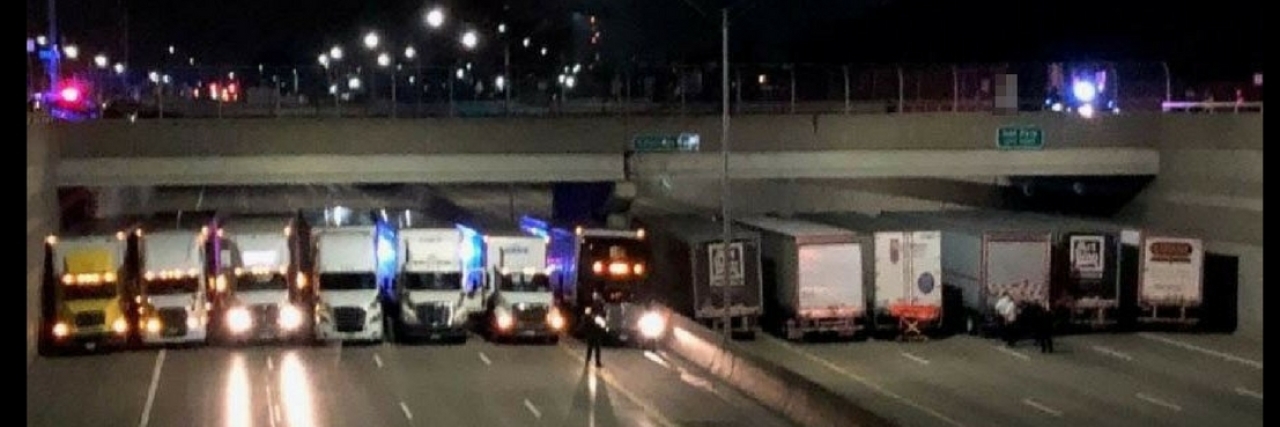What to Remember If You See This Viral Photo of a Man in a Suicidal Crisis
Sometimes the news isn’t as straightforward as it’s made to seem. Sarah Schuster, The Mighty’s mental health editor, explains what to keep in mind if you see this topic or similar stories in your newsfeed. This is The Mighty Takeaway.
Editor's Note
If you experience suicidal thoughts or have lost someone to suicide, the following post could be potentially triggering. You can contact the Crisis Text Line by texting “START” to 741741.
On Tuesday, Michigan State Police shared a photo on Twitter to show a unique way it responded to a suicidal crisis. When a man threatened to jump off a highway overpass, 13 semi-truck drivers showed up and blocked the highway in order to shorten his fall.
The department shared the powerful photo with the caption, “This photo does show the work troopers and local officers do to serve the public. But also in that photo is a man struggling with the decision to take his own life.”
This photo does show the work troopers and local officers do to serve the public. But also in that photo is a man struggling with the decision to take his own life. Please remember help is available through the National Suicide Prevention Lifeline at 1-800-273-8255. pic.twitter.com/RBAlCIXT1o
— MSP Metro Detroit (@mspmetrodet) April 24, 2018
The photo has now been retweeted over 5,000 times. While it’s heartwarming to see truck drivers took the time to help this man, the image also serves as an important reminder about suicide prevention — when trying to prevent suicide, we can’t forget that means restriction matters.
“Means restriction” requires putting space between a person who’s suicidal and the method they can use to kill themselves. Cathy Barber, who directs the Means Matter Campaign at the Harvard School of Public Health’s Injury Control Research Center (HICRC), said in this particular example, using the trucks to shorten the man’s fall serves a dual purpose — it shows solidarity and support and makes his suicide method less lethal.
“Having a concrete expression of support and hope from the people around you, and some space between you and the thing that can kill you, both of those things can really help you in the longer term,” she told The Mighty.
While many people who’ve attempted suicide struggle with chronic depression, substance abuse or have a history of trauma, “the acute period of heightened risk for suicidal behavior is often only minutes or hours long,” according to the Means Matter Campaign. Barber said many people who try to kill themselves end up stopping mid-attempt, and 90 percent of people who attempt suicide and survive will not go on to die by suicide at a later date. When people use more lethal methods, like pulling a trigger or jumping off a bridge, they aren’t afforded that chance to change their minds.
Barber added:
If you have something that is really easily going to kill you, you end up dead. You don’t have the chance to recover. If you’re afforded more time, maybe a few days later you’re still miserable, but not that miserable. And a few months later, you’re actually feeling OK. And the next year, you feel a little bit better. You want to give people that opportunity to get through the worst of those dark moments.
Another example of means restriction includes offering to store a gun owner’s gun if you notice they’re going through a rough time. Firearms are the most lethal suicide method. You can “pull the trucks under the bridge,” as Barber said, by making sure there’s some distance between your loved one and their gun.
According to Fox, the man the Michigan State Police were trying to save did not jump and was instead taken to a hospital for evaluation. While keeping someone alive is an important part of the suicide prevention story, it’s only the first step.
If this man ends up being hospitalized, we can’t forget that people who stay in psychiatric hospitals have a suicide rate 100 times higher than the global average within three months of being discharged. We don’t know what this man’s story is; if he has access to services and support or if he’s experienced trauma, loss or is living in poverty.
Yes, we should celebrate the efforts of the police department and use this photo as a reminder of how effective means restriction can be, but we can’t forget the man on the bridge’s story is not over.
Even when we can’t assemble a fleet of trucks, those who are suicidal need our support.

